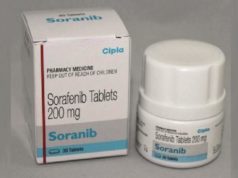By Alexandre Laurent, Laurent Bédouet and Laurence Moine
Chemoembolization with sorafenib (Bayer and Onyx Pharmaceuticals) is a promising technique for the treatment of hepatocellular carcinoma (HCC) because, administered orally (400–800mg daily), it is associated with increased three-month survival.1 Also, the combination of sorafenib and transarterial chemoembolization (TACE) has been shown to increase the time to progression and patient survival compared with TACE alone.2 Sorafenib has been approved for treatment of advanced HCC since 2008, but local delivery of the therapy is a new concept. Alexandre Laurent, Laurent Bédouet, and Laurence Moine review the data for sorafenib in this context.
Local delivery of sorafenib has been studied in animal models. In a rabbit study, Lip-TACE with lipiodol emulsions of sorafenib was found to be technically feasible and increased the concentration of drug in healthy liver by several times compared to the therapeutic drug concentrations (2–10μg/mL) observed in plasma during oral treatment.3 In a VX2 tumour model, Lip-TACE concentrates the drug in the tumour compared to the healthy liver, before a rapid clearance of the drug (5.2 hour half-life) and an important systemic exposure of 58μg/mL.4
An extemporaneous loading of sorafenib by ionic mechanism as for doxorubicin on microspheres, such as LC Bead (BTG) or Hepasphere/Quadrasphere (Merit Medical), is difficult for two reasons. First, sorafenib is devoid of any cationic function, precluding its ionic attraction; and second, sorafenib is a hydrophobic molecule having low-water solubility. Its loading on LC Bead has been attempted but two days in highly diluted conditions (20μg/mL) are required to achieve a loading of 10mg/mL and the release occurs quickly (50% is released in vitro within one hour).5 Today, new materials and new loading procedures are necessary for sorafenib delivery.
Degradable microspheres for sorafenib delivery
A degradable microsphere could have three advantages over non-degradable microsphere. First, the degradable carrier allows a complete drug delivery, thus avoiding the risk of toxicity that could come from a long-term delivery of infra-therapeutic doses of drug. Second, a complete arterial recanalisation allows you to repeat the chemoembolization procedures. Third, the re-opening of the lumen could reduce the post-embolization angiogenesis and the risk of post-embolization syndrome.
We studied the loading of sorafenib on a degradable microsphere (PEG-MS, Occlugel) composed of polyethyleneglycol monomer cross-linked with a degradable PEG-PLGA triblock crosslinker.6 Previously, we have shown different size ranges of PEG-MS (300–500μm, 500–700μm, and 700–900μm) that degrade in one day, occlude pig renal arteries according to their size and give way to full recanalisation after one week.7
The particular composition of the PEG-MS, comprising both hydrophilic and hydrophobic moieties, is prone to favour the loading of a neutral drug such as sorafenib by weak interactions, different from ionic attractions. Our first in vitro trials were positive. Sorafenib could be loaded in less than one hour, simply by mixing it with the PEG-MS (size range of 50–100μm) at room temperature in a medium composed of water and dimethyl sulfoxide (DMSO). The maximum sorafenib load was around 13mg/mL of microspheres, with an efficacy of loading of 70%. The loading of the hydrophobic sorafenib on the PEG-MS did not induce aggregation of the PEG-MS and did not hinder their deliverability through a microcatheter. Interestingly, the drug release in saline medium occurred without a burst and was gradual and proportional to the microsphere degradation. The delivery was complete when the PEG-MS were fully hydrolysed. This sustained release suggests an efficient interaction between sorafenib and the microsphere. In vitro, the viability of HepG2 cells was reduced by sorafenib eluted from PEG-MS, showing that the drug activity was not modified by its loading.
Our preliminary results are promising: hydrophobic and neutral sorafenib can be promptly loaded at a significant concentration on a degradable PEG-MS. Its delivery is proportional to the rate of degradation of the embolic and it is complete. It could be interesting to investigate the optimal delivery time (microsphere degradation time) with regard to anti-tumour efficiency and recanalisation.
References
- Llovet et al. N Engl J Med 2008; 359(4): 378–90
- Bai et al. J Dig Dis 2013; 14(4): 181–90
- Gaba et al. J Vasc Interv Radiol 2013; 24(5): 744–50
- Parvinian et al. Diagn Interv Radiol 2015; 21(3): 235–40
- Lahti et al. J Vasc Interv Radiol 2015; 26(2): S80–S81
- Louguet S et al. Acta Biomater 2013; 10(3): 1194–205
- Maeda N et al. J Vasc Interv Radiol 2013; 24(9): 1391–98
Alexandre Laurent is at AP-HP Hôpital Lariboisière, Department of Neuroradiology, Paris, France; Laurent Bédouet is at Occlugel SAS, Jouy en Josas, France; and Laurence Moine is at Institut Galien Paris-Sud, CNRS, Univ. Paris-Sud, Université Paris-Saclay, Châtenay-Malabry, France. AL is a founder and member of the scientific board of Occlugel. The authors are co-inventors in a patent on the resorbable microsphere discussed in the article













